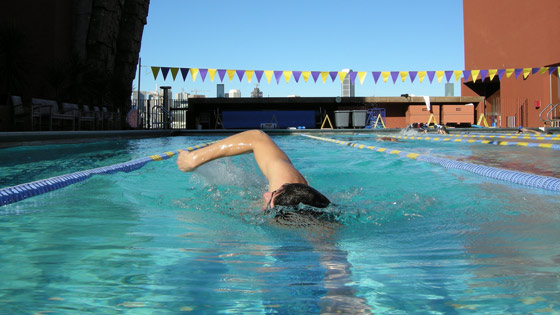 Before swimming in a public pool, check with the pool operator to find out when the water was last treated. It should be treated up to two times per day, says UHN expert Dr. Michael Gardam. (Photo: SuperFantastic/Flickr)
Before swimming in a public pool, check with the pool operator to find out when the water was last treated. It should be treated up to two times per day, says UHN expert Dr. Michael Gardam. (Photo: SuperFantastic/Flickr)
We sat down with Dr. Michael Gardam, UHN's Director of Infection Prevention and Control to get the skinny on pool-borne viruses.
UHN.ca: Do you swim in a public pool?
Dr. Gardam: Of course! I swim three times a week in a public pool in Toronto.
I feel comfortable swimming in a public pool because The City of Toronto has strict regulations to follow for the care and management of each pool. So it's unlikely an outbreak would be a caused from not chlorinating the pool regularly enough. It's more likely that there would be an outbreak in a residential pool due to human error.
UHN.ca: What is the most common virus people get from swimming pools?
Dr. Gardam: The most common virus contracted in swimming pools is known as Recreational Water Sickness. It's a general term that can include a number of infections including gastrointestinal infections like diarrhea, skin infections, ear infections and sometimes respiratory infections.
UHN.ca: How can people contract a Recreational Water Sickness?
Dr. Gardam: Recreational Water Sickness is most commonly transmitted from swallowing water with the bacteria in it. Germs such as Crypto (short for Cryptosporidium), Giardia, Shigella, norovirus and E. coli are usually caused when people urinate or defecate in the pool.
UHN.ca: Doesn't chlorine kill all the germs in a pool?
Dr. Gardam: Chlorine does kill most bacteria in the pool but it completely depends on how often the pool is getting treated and at what time the bacteria entered into the pool.
The germ Crypto, can stay alive for days even in well-maintained pool and has become the leading cause of swimming pool-related outbreaks of diarrheal illness.
UHN.ca: Can you get sick from a hot tub?
Dr. Gardam: Yes, you can. The most common bacteria people can get from a hot tub is, "Hot Tub Rash" caused by a germ called Pseudomonas aeruginosa. It causes an itchy red rash that could remain on the skin for a few days.
A less common, but far more dangerous disease from a hot tub is called "Hot Tub Lung".
It's caused by
Nontuberculous mycobacteria (NTM) - a pathogen that lives in water and grows in warm temperatures. Lung inflammation usually occurs when a patient breathes in the airborne NTM into their lungs. This can cause severe lung inflammation in otherwise healthy individuals and can cause infection in those who have weakened immune systems.
UHN.ca: How should people protect themselves when swimming in a pool or hot tub?
Dr. Gardam: First check with the pool or hot tub operator to find out when the water was last treated. It should be treated up to two times per day. Make sure to shower with soap after swimming and if it looks like there is a slime or biofilm on top of the water – don't swim until it's removed or washed.
For more information on how to protect you and your family from Recreational Water Illness, please visit the
Centres for Disease Control and Prevention website.
Related
Summer festivals: 5 tips for staying safe
Summer Health Series: How to protect your skin this summer
